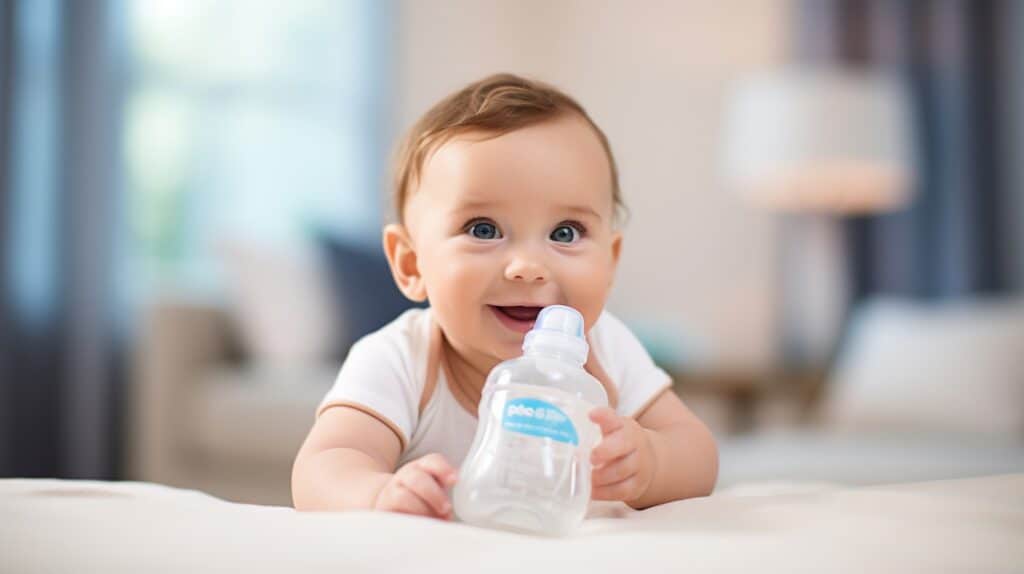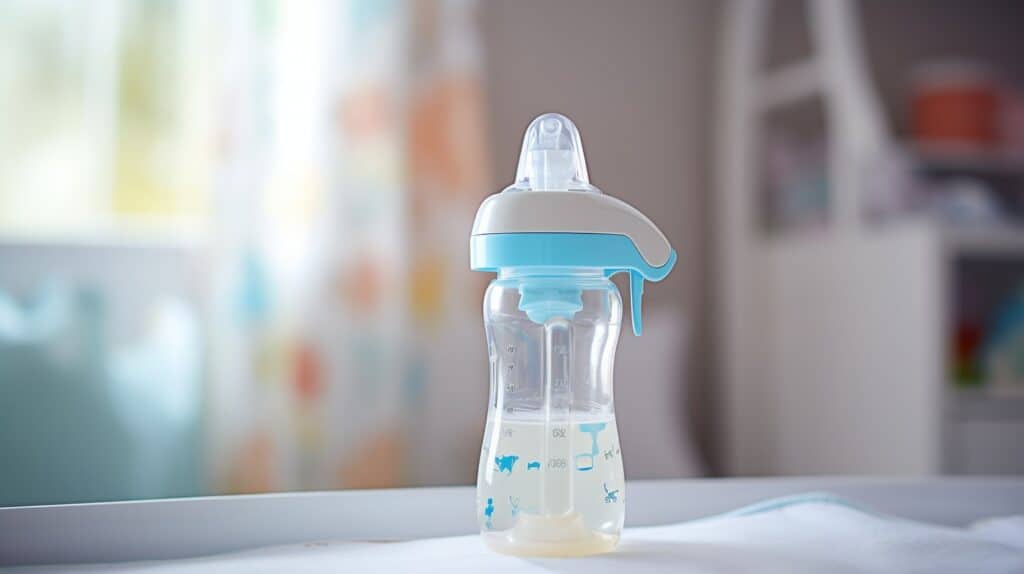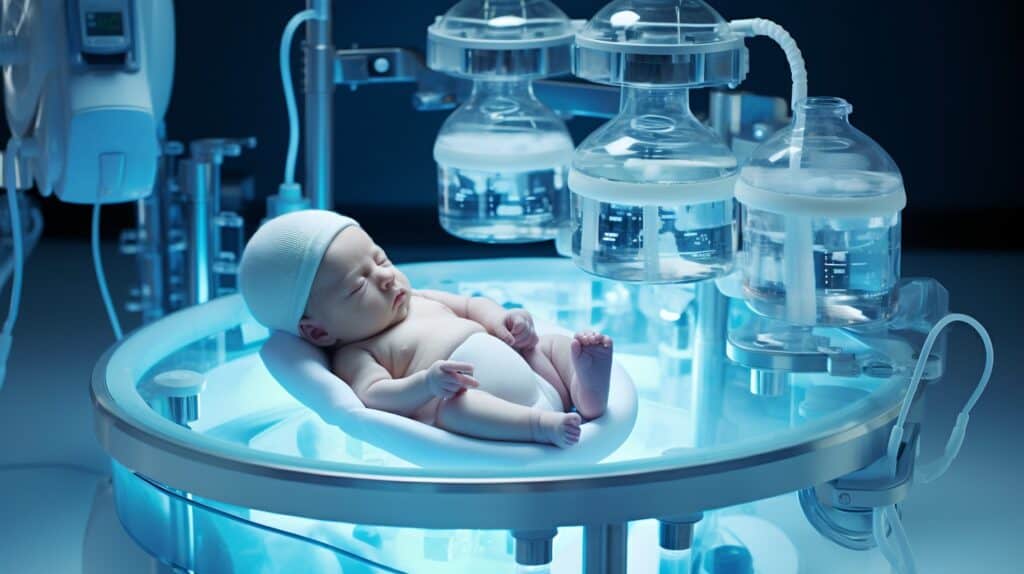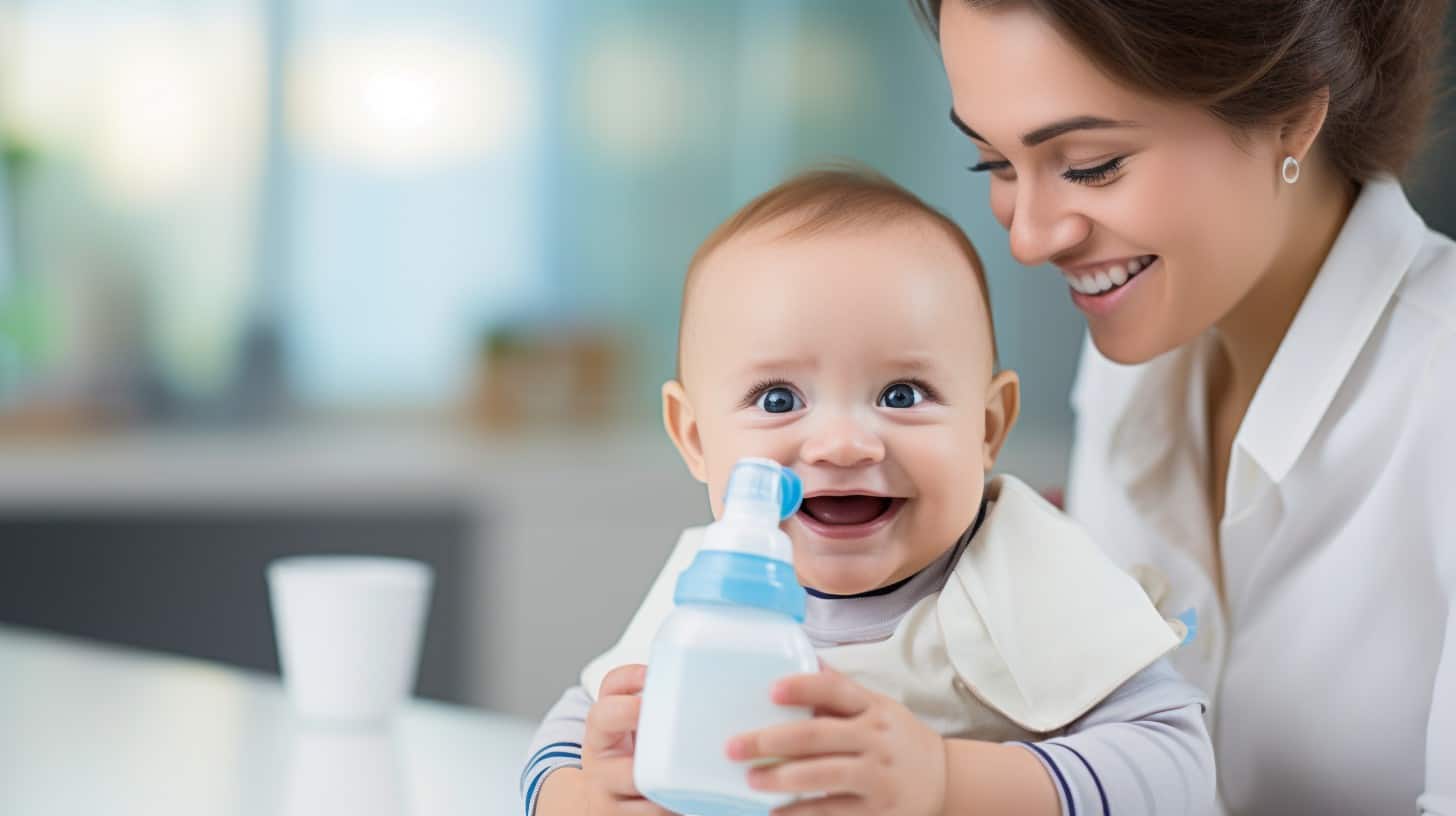Navigating the stormy seas of baby nutrition can be daunting, especially when food sensitivities throw a wrench into meal times. As a parent, you try to make sense of labels and figure out what will nourish your little one without causing upset.
That’s where hydrolyzed protein formula comes into play—it’s crafted to cater to those dietary hurdles by simplifying proteins into more digestible forms for delicate infant stomachs.
In this article, we’ll explore the gentle relief this special formula can offer, providing insight to help your precious child flourish with ease and comfort. Join me as we uncover how it could be the nutritional lifeline you’ve been searching for!
Key Takeaways
Hydrolyzed protein formulas can be easier for babies to digest, especially if they have a milk allergy or intolerance. These special formulas break proteins into smaller pieces, which can help lower the chances of allergic reactions.
There are two main types of hydrolyzed formulas: extensively and partially hydrolyzed. The extensively hydrolyzed ones are broken down more and may be better for infants with severe allergies, while the partially hydrolyzed options might be good for mild sensitivities.
Before choosing a hydrolyzed formula, it’s important to talk to your pediatrician. They know your baby’s health history and needs, plus they can advise on whether this type of formula will benefit your little one based on their specific conditions.
Transitioning from breast milk or regular formula to a hydrolyzed one should be done slowly. Mixing small amounts at first and gradually increasing them helps babies get used to the new taste without getting upset tummies.
Some popular brands that make these formulas include HiPP HA Germany Hydrolyzed for severe allergies and HiPP Dutch HA Hydrolyzed for milder concerns. Parents should consider their baby’s tastes because some may not like the different flavors of hydrolyzed formulas right away.
Table of Contents
Understanding Hydrolyzed Protein Formulas

Understanding Hydrolyzed Protein Formulas is key to grasping why a product like HiPP hypoallergenic formula could be an excellent choice for your little one’s dietary needs. This approach breaks down complex proteins, making them easier for sensitive infant tummies to handle and potentially lessening the risk of allergies.
The Science of Hydrolysis in Infant Formula
I want to tell you about how hydrolysis works in baby formulas. It’s like cutting up a big piece of food into tiny bits so a baby can easily swallow and digest it. In infant formula, special helpers called enzymes break down the milk proteins into smaller parts.
This process is super important because some babies’ tummies are sensitive or allergic to big milk protein pieces found in cow’s milk or regular formula.
Now, there are two types of these special formulas: extensively hydrolyzed and partially hydrolyzed. The extensively hydrolyzed ones chop the proteins into very small pieces—kinda like turning chicken nuggets into breadcrumbs! These tiny bits are less likely to cause allergic reactions for babies who really can’t handle cow’s milk proteins at all.
Partially hydrolyzed formulas don’t break down the protein as much; think more like cutting the chicken nuggets into halves or quarters—not as fine as breadcrumbs but still easier for little stomachs than whole ones.
This helps many babies digest their food better and stay happy after mealtime!
Extensively vs. Partially Hydrolyzed Formulas
Delving deeper into hydrolyzed protein formulas, it’s crucial to understand the differences between extensively hydrolyzed and partially hydrolyzed options. Each type has its own role and implications for infant nutrition, and as a parent, knowing these can help make informed decisions for your baby’s health.
| Feature | Extensively Hydrolyzed Formulas (EHF) | Partially Hydrolyzed Formulas (PHF) |
|---|---|---|
| Protein Breakdown | Proteins are broken down into very small fragments. | Proteins are broken into larger peptides than EHF. |
| Allergenicity | Lower residual allergenicity, suitable for infants with cow’s milk protein allergy. | Lower allergenicity than regular formulas but unsuitable for babies with a diagnosed milk allergy. |
| Digestion and Absorption | Designed for optimal digestion and absorption in babies with severe allergies. | Easier to digest than standard formulas, can aid in reducing colic symptoms. |
| Taste | May have a bitter taste due to extensive hydrolysis. | More palatable than EHF, closer in taste to standard formulas. |
| Clinical Evidence | Supported by clinical studies for managing allergies in infants. | Clinical evidence is insufficient for universal recommendation; discussions with healthcare professionals are crucial. |
As a parent navigating the world of infant nutrition, knowing the nuances between extensively and partially hydrolyzed formulas can be overwhelming. Yet, it’s essential to assess your baby’s individual needs. While EHF may be necessary for infants with significant allergies, PHF might be suitable for those with mild sensitivities. Remember, though, that a healthcare professional’s guidance is invaluable when deciding which formula is the best fit for your little one.
The Role of Hydrolyzed Protein in Infant Nutrition

Hydrolyzed protein becomes a game-changer in infant nutrition for those little ones grappling with milk allergies or sensitive tummies. It’s not just about feeding; it’s about providing a gentle touch to their developing digestive systems and immune responses, making every spoonful count towards their well-being.
Benefits for Babies with Milk Allergy or Intolerance
Babies with milk allergy or intolerance can really struggle. Their little bodies react badly to the proteins found in cow’s milk or sometimes even in breast milk. But here’s some good news! Hydrolyzed protein formula breaks down those tough-to-digest proteins.
This means babies who drink it don’t have to fight off big protein pieces that cause allergies and upset tummies.
We’ve seen from studies that things like crying, throwing up, and hard poops get better with hydrolyzed formulas. They are safe and help babies grow just right. And if your baby deals with a fussy tummy, switching to a hydrolyzed formula might make feeding time much happier for both of you! Now, let’s look at how this special formula matches up against the regular kind.
Easier Digestion and Absorption for Infants
Hydrolyzed protein formula can make a big difference for little tummies. Think of it like this: regular proteins are long chains that need to be broken down, which can be hard for infants.
But hydrolyzed proteins are like shorter, easier-to-handle pieces. These smaller pieces mean your baby’s stomach doesn’t have to work as hard to break them down and soak up the good stuff.
Now, I’ve seen how tough it is when babies struggle with gas or constipation—it’s heartbreaking! Hydrolyzed formulas are here to help ease these tummy troubles by being gentler to digest.
They’re crafted just right so your baby can absorb nutrients better and maybe even dodge those pesky colic episodes. Next up, let’s talk about comparing hydrolyzed protein with other kinds of formulas out there.
Comparing Hydrolyzed Protein to Regular Formulas

Understanding the differences between hydrolyzed protein and regular infant formulas is crucial for parents making nutrition decisions for their little ones. I’ll delve into whether hydrolyzed formulas offer unique benefits or if traditional options can meet your baby’s dietary needs just as effectively.
Nutritional Differences and Similarities
As parents, we’re always striving to provide the best nutrition for our growing infants. When considering hydrolyzed protein formulas, it’s fundamental to grasp how they match up nutritionally to regular formulas. Here’s a breakdown of the differences and similarities to help you navigate your choices:
| Nutrition Aspect | Hydrolyzed Protein Formula | Regular Formula |
|---|---|---|
| Protein Composition | Composed of peptides of various sizes, easier to digest | Contains intact proteins which are larger and harder to digest |
| Allergenic Potential | Lower allergenicity due to broken down proteins | Higher potential for allergic reactions with intact protein |
| Digestibility | Partial hydrolysates are more easily digested | May pose digestion challenges for some infants |
| Nutritional Content | Formulated to meet the standard nutritional requirements | Meets the standard nutritional requirements for infant growth |
| Taste | Might have a different taste due to the hydrolysis process | Generally accepted by infants, closer to the taste of breast milk |
| Prevention of Allergic Disease | Not shown to conclusively reduce allergy prevalence | No impact on allergy prevention noted |
The choice between a hydrolyzed protein formula and a regular one isn’t solely about differences in nutrition; it’s also about the unique needs of your baby. Now, let’s delve into how these formulas affect infant feeding practices.
Taste and Acceptance by Infants
Just like us, babies prefer certain tastes over others. Hydrolyzed protein formulas might taste a bit different from regular formulas because of the way the proteins are broken down.
Some parents worry their little ones may not like this taste. But many infants take to it just fine, especially if they start on hydrolyzed formula early on. In fact, studies show that when babies with milk allergies switch to a hydrolyzed formula, they often accept it without any fuss.
We know every baby is unique, and what works for one may not work for another. This includes how well they accept the taste of hydrolyzed protein formula. If you’re thinking about trying this type of formula for your baby, it’s all about giving it a go and watching how your baby responds.
Over time, most infants get used to the new flavor and continue to grow healthy and strong without any problems with feeding or nutrition.
Hydrolyzed Formula and Infant Feeding Practices

Hydrolyzed protein formulas often become the focus of attention for parents navigating feeding options, especially when they’re faced with specific dietary needs or health concerns for their infants.
With an ever-evolving landscape of infant nutrition, understanding how to incorporate these specialized formulas into your little one’s diet can have a profound impact on their growth and well-being.
Indications for Choosing Hydrolyzed Formula
I know picking the right formula for your baby can be tough. If you’re thinking about hydrolyzed formula, here are some reasons it might be a good choice:
- Your baby has a milk allergy or intolerance. Hydrolyzed formulas break down the proteins, which can help babies who react to cow’s milk.
- Doctors say it could prevent some allergies. Studies show that partially hydrolyzed formulas may lower the chances of skin problems like atopic eczema and asthma.
- Eczema or other allergies run in your family. Babies with parents or siblings who have these conditions might benefit from hydrolyzed formula.
- Your little one has trouble with digestion. These formulas can be easier for babies to digest than regular ones.
- Standard formulas cause fussiness or gas. If your baby seems uncomfortable after feedings, hydrolyzed formula may help.
- You and your healthcare professional decide it’s best. Always talk with a pediatrician before switching formulas to make sure it fits your baby’s needs.
Transitioning from Breast Milk or Standard Formula
Switching your baby to hydrolyzed formula from breast milk or a standard formula can be a big step. You might choose this option if your little one has food allergies, milk intolerances, or trouble with digestion.
Can You Mix Hydrolyzed with Standard Formulas?
Moving from breast milk or traditional formula to hydrolyzed formulas might make you wonder if you can mix the two types. Some parents want to do this to help their baby get used to the new taste or because of concerns about food allergies.
It’s vital you talk with your pediatrician before mixing formulas, as every baby is unique. Your doctor knows your child’s health needs and can guide you on how best to feed them.
If you’re thinking about combining hydrolyzed and regular formulas, consider that each serves different purposes. Hydrolyzed formula breaks down proteins, which can be easier on babies’ tummies and less likely to cause a reaction in those with milk protein intolerance or allergies.
Regular formulas have whole proteins that might be harder for some infants to digest if they have sensitive systems or food intolerances. Mixing without guidance could upset your baby’s stomach or cause other problems, so getting a doctor’s advice is essential before trying it out.
Selecting the Right Hydrolyzed Formula for Your Baby

When faced with a multitude of hydrolyzed formula options, it’s crucial to pinpoint the one that aligns best with your little one’s unique needs and health considerations. I’ll guide you through the considerations that matter most, from dietary restrictions to nutritional balance, ensuring your choice supports your baby’s growth and wellness journey.
Factors to Consider When Choosing a Formula
Choosing the right formula for your baby is important. You want to make sure it meets all their needs. Here are things to think about:
- Baby’s Age: Look for a formula that fits your baby’s stage. Newborns have different needs than older babies.
- Health Needs: If your baby has cow’s milk allergy or lactose intolerance, hydrolyzed protein formula can help.
- Doctor’s Advice: Ask your pediatrician before you pick a formula, especially if your baby has health issues.
- Allergy Risk: Does food allergy run in your family? A hydrolyzed formula might lower the chance of allergic reactions.
- Digestion: Some babies digest certain formulas better. Hydrolyzed ones break down proteins, making digestion easier.
- Nutrient Content: Make sure the formula has all the nutrients, like vitamins and minerals that babies need to grow.
- Taste Preferences: Babies can be picky with taste. You might need to try a few before finding one they like.
- Formula Type: There are both partially and extensively hydrolyzed formulas. Your choice depends on what your baby needs.
- Cost: Hydrolyzed formulas can cost more. Think about what you can afford when choosing.
Popular Hydrolyzed Formula Brands on the Market
After considering all the essential factors in selecting a suitable formula, let’s explore some of the popular brands that offer hydrolyzed options for your little one’s nutritional needs. These brands have crafted specialized formulas to cater to infants with dietary sensitivities and allergies, ensuring your baby receives the necessary nutrients without discomfort.
| Brand | Type | Targeted Needs | Taste Acceptance |
|---|---|---|---|
| HiPP HA Germany Hydrolyzed | Extensively Hydrolyzed | Severe food allergies | High |
| HiPP Dutch HA Hydrolyzed | Partially Hydrolyzed | Mild to moderate sensitivities | High |
| HiPP Comfort Milk Formula | Extensively Hydrolyzed | Food allergies and sensitivities | Favorable |
Each of these hydrolyzed formula brands meticulously breaks down proteins to create a product that is not only easier for babies to digest but also less likely to trigger allergic reactions. With their focus on quality and palatability, these formulas are well-received by infants, making mealtime a happy, fuss-free experience for both baby and parents.
Consulting Healthcare Professionals

As the journey through infant nutrition unfolds, it’s essential to forge a partnership with healthcare professionals. They are equipped to personalize advice for your baby’s unique needs, ensuring that any transition to a hydrolyzed protein formula is smooth and beneficial for their growing bodies.
When to Consult Your Pediatrician
I know being a parent means I’m always looking out for my little one’s health. If my baby has trouble with regular formulas, like GI issues, or cries as if they have colic, I don’t wait to get help.
My pediatrician can tell me what’s going on and if a hydrolyzed protein formula might be better.
Sometimes, babies show signs of milk allergies – things like hives, puffy skin, throwing up, or having a stuffy nose that won’t go away. If this happens with my child, a quick call to the doctor is important.
They can do allergy testing and guide us through finding the right food for my baby’s tummy. It’s all about keeping them happy and healthy after all!
Monitoring Your Baby’s Progress on Hydrolyzed Formula
Talking with your pediatrician is a key step before starting a hydrolyzed formula. Once your baby begins this new feeding, keep an eye on how they do with it. You want to see if their tummy is happy and they are growing well.
Some babies might have been fussy or had trouble pooping before. With hydrolyzed formula, these problems may get better because the proteins are easier for them to digest.
You also want to watch out for any allergy signs. Remember that even though hydrolyzed formulas break down proteins, allergies can still happen, but less likely than with cow’s milk-based formulas.
If you notice rashes like atopic dermatitis or other allergy symptoms, talk to your pediatrician right away. They will help you figure out what’s going on and what’s best for your little one’s health.
The Future of Infant Nutrition

As we gaze into the horizon of infant nutrition, innovative strides in hydrolyzed formula production are paving the way for even more refined and nutritious options tailored to our little ones’ needs.
With cutting-edge research constantly emerging, parents can look forward to a landscape where feeding practices evolve alongside scientific insight, ensuring healthier beginnings for every child.
Innovations in Hydrolyzed Formula Manufacturing
Making hydrolyzed protein formulas is getting better all the time. Companies have their own ways of breaking down proteins in formula, which can change how well a baby’s body accepts it.
This process is important because smaller pieces of proteins are easier for babies to handle, especially if they have milk allergies or trouble with digestion.
Some smart people are trying new things to make these formulas even safer and better for babies. They look at different ways to cut up the protein molecules so that there’s less chance of an allergy.
They also try to keep as much of the good stuff from human milk in the formula as they can. Every step forward helps your child learn faster and makes their immune system stronger without triggering allergic reactions like peanut allergy or egg allergy.
Trends in Baby Feeding and Nutrition
Parents today have more options than ever for feeding their babies. New trends in baby nutrition are all about giving your little one the best start. Many parents are now looking at how formulas like hydrolyzed protein can help with allergies or tummy troubles.
Studies even suggest these special formulas could ease things like colic and constipation.
People also keep searching for ways to make formula closer to breast milk. This push has led to new ingredients and methods in formula-making. Experts always look for better ways to feed babies who can’t be breastfed, keeping their growth on track.
Now, let’s talk about why some parents pick hydrolyzed formulas over regular ones.
Is Hydrolyzed Protein Formula Right for Your Baby?
I’ve learned a lot about hydrolyzed protein formulas, and I feel good knowing there are special formulas for babies who may not handle regular ones well. It’s cool that science can help make proteins easier to digest for little tummies.
If you’re thinking about what food is best for your baby, remember these formulas might be a helpful choice. Always talk with doctors to find the perfect fit for your child’s nutrition needs.
Here’s to happy and healthy feeding times!
FAQs About Hydrolyzed Protein Formula
What is hydrolyzed protein formula?
Hydrolyzed protein formula breaks down proteins, like casein or whey from cow’s milk and goat’s milk, into smaller pieces called peptides. This can be easier for babies to digest.
Why do doctors recommend hydrolyzed formula for babies?
Pediatricians might suggest a hydrolyzed formula if a baby has problems like allergies or infantile colic because it can help prevent allergic reactions and is gentle on the stomach.
Can hydrolyzed formula stop my baby from getting allergies?
Studies show that this type of formula can lower the risk of allergic sensitization in some kids, including those with risks such as having an autistic child or a child with other specific health concerns.
Is feeding my baby only hydrolyzed protein formula okay?
Exclusive breastfeeding is often suggested for newborns, but when that’s not possible, feeding your kid a hydrolyzed protein-based formula could be helpful, especially if suggested by your doctor.
Are there studies showing how good this type of infant food is?
Yes! Many systematic reviews and meta-analyses provide evidence-based information backing certain health claims about these formulas helping with issues like allergen prevention in preterm infants.
What are IgE antibodies and oral tolerance related to baby foods?
IgE antibodies are part of our body’s defense system against things we might be allergic to (allergens). Feeding peptide fragments through these specially processed formulas may train the body toward oral tolerance—meaning it gets used to these substances without reacting badly.



